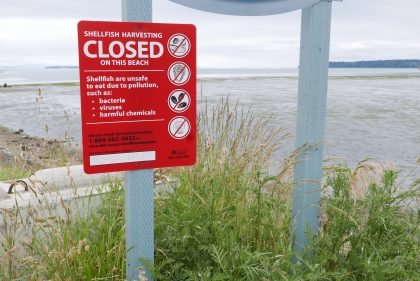By Oliver Lazenby
The Washington State Department of Health (DOH) closed all Whatcom County beaches north of Sandy Point for recreational harvest of molluscan shellfish last week. During routine testing, the agency found unsafe levels of a dangerous biotoxin that can cause paralytic shellfish poisoning (PSP), which is produced by some species of algae.
The toxin affects the nervous system and can paralyze muscles, hence the name. The closure is specific to molluscan shellfish, including clams, mussels, oysters and scallops. The toxin doesn’t accumulate in crab meat, but it can in “crab butter” and internal organs, and those should be discarded, according to press release from the DOH.
 All Whatcom County beaches north of Sandy Point are closed for recreational harvest of molluscan shellfish. Photo by Oliver Lazenby.
All Whatcom County beaches north of Sandy Point are closed for recreational harvest of molluscan shellfish. Photo by Oliver Lazenby.
It’s impossible to tell if shellfish contain PSP without a laboratory test, and cooking does not make affected shellfish safe to eat.
The county and state will continue testing for toxins weekly, and will notify the public when beaches reopen, said Melissa Morin, communications specialist with the Whatcom County health department. The algal blooms that produce the toxin happen when water conditions are favorable, but the exact conditions that cause the blooms are unknown.
“Typically the levels of the toxin fluctuate all summer, and there are just so many factors that go into it,” Morin said. “Usually this happens every summer.”
For now, most popular beaches have signs alerting the public of the closure.
Oysters safe at Drayton Harbor Oyster Co.
The recreational closure doesn’t affect Drayton Harbor Oyster Co. or other commercial harvesters, because the state has a separate process for testing commercial shellfish.
When the DOH finds PSP toxins in mussels during routing testing, commercial harvesters must begin sending weekly samples of their product to the Washington State Public Health Laboratory for testing.
Different shellfish species accumulates and purge the toxin at different rates. The level of the biotoxin in mussels is often 10 times higher than in oysters and some other species, according to a report by the Canadian government.
Steve Seymour, owner of Drayton Harbor Oyster Co., sent samples to the state last week – when the recreational harvest closure started – that didn’t have any detectable PSPs, he said.
“That’s not unusual,” Seymour said. “It seems like oysters, for one reason or another, don’t concentrate the toxin as much as mussels and clams.”
Closure can represent a public relations problem that has frustrated Seymour in the past. He’s not sure if recreational shellfish closures affect his business, but people certainly ask more questions when recreational harvesting is closed, he said.
“We just have to spend some explaining to people at the farmers market that the commercial products are sampled separately and, at this time, are safe,” he said.
Comments
No comments on this item Please log in to comment by clicking here